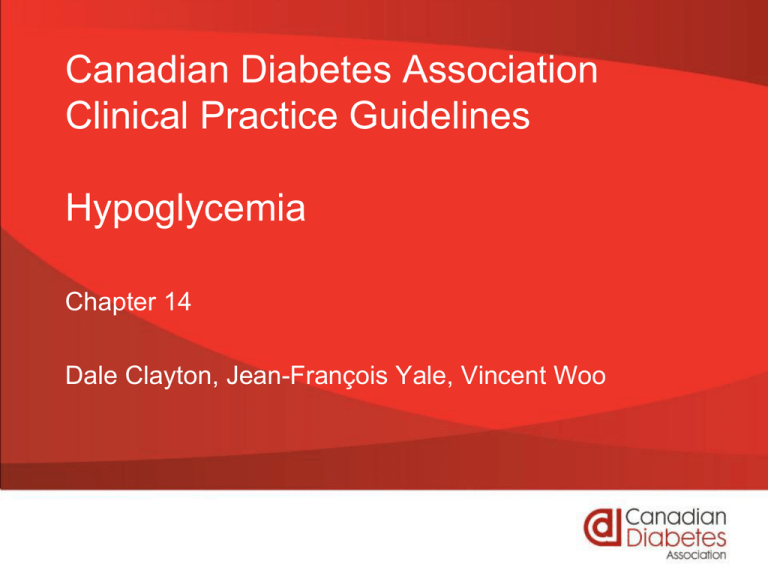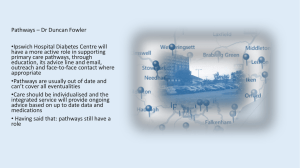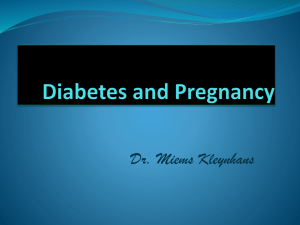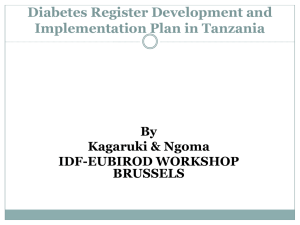Severe hypoglycemia - Canadian Diabetes Association
advertisement

Canadian Diabetes Association Clinical Practice Guidelines Hypoglycemia Chapter 14 Dale Clayton, Jean-François Yale, Vincent Woo Hypoglycemia Checklist 2013 RECOGNIZE hypoglycemia and CONFIRM DIFFERENTIATE mild-moderate vs. severe TREAT hypoglycemia but AVOID overtreatment AVOID hypoglycemia in the future guidelines.diabetes.ca | 1-800-BANTING (226-8464) | diabetes.ca Copyright © 2013 Canadian Diabetes Association Definition of Hypoglycemia 1. Development of neurogenic or neuroglycopenic symptoms Neurogenic (autonomic) Neuroglycopenic Trembling Difficulty Concentrating Palpitations Confusion Sweating Weakness Anxiety Drowsiness Hunger Vision Changes Nausea Difficulty Speaking Dizziness 2. Low blood glucose (<4 mmol/L if on insulin or secretagogue) 3. Response to carbohydrate load guidelines.diabetes.ca | 1-800-BANTING (226-8464) | diabetes.ca Copyright © 2013 Canadian Diabetes Association Severity of Hypoglycemia • Mild – Autonomic symptoms present – Individual is able to self-treat • Moderate – Autonomic and neuroglycopenic symptoms – Individual is able to self-treat • Severe – Requires the assistance of another person – Unconsciousness may occur – Plasma glucose is typically <2.8 mmol/L guidelines.diabetes.ca | 1-800-BANTING (226-8464) | diabetes.ca Copyright © 2013 Canadian Diabetes Association Drug Induced Hypoglycemia • Can result in significant morbidity and mortality • Serious obstacle to meet glycemic targets • Counsel patients who drive on insulin or secretagogues re: self-monitoring of blood glucose and taking appropriate precautions guidelines.diabetes.ca | 1-800-BANTING (226-8464) | diabetes.ca Copyright © 2013 Canadian Diabetes Association Steps to Address Hypoglycemia 1. Recognize autonomic or neuroglycopenic symptoms 2. Confirm if possible (blood glucose <4.0 mmol/L) 3. Treat with “fast sugar” (simple carbohydrate) (15 g) to relieve symptoms 4. Retest in 15 minutes to ensure the BG >4.0 mmol/L and retreat (see above) if needed 5. Eat usual snack or meal due at that time of day or a snack with 15 g carbohydrate plus protein guidelines.diabetes.ca | 1-800-BANTING (226-8464) | diabetes.ca Copyright © 2013 Canadian Diabetes Association Examples of 15 g Simple Carbohydrate • 15 g of glucose in the form of glucose tablets • 15 mL (3 teaspoons) or 3 packets of sugar dissolved in water • 175 mL (3/4 cup) of juice or regular soft drink • 6 Lifesavers (1=2.5 g of carbohydrate) • 15 mL (1 tablespoon) of honey guidelines.diabetes.ca | 1-800-BANTING (226-8464) | diabetes.ca Copyright © 2013 Canadian Diabetes Association Recognize Risk Factors for Severe Hypoglycemia Risk factors in Type 1 DM patients Risk factors in Type 2 DM patients Adolescence Elderly Children unable to detect and/or treat mild hypoglycemia Poor health literacy, Food insecurity A1C <6.0% Increased A1C Long duration of diabetes Duration of insulin therapy Prior episode of severe hypoglycemia Severe cognitive impairment Hypoglycemia unawareness Renal impairment Autonomic neuropathy Neuropathy guidelines.diabetes.ca | 1-800-BANTING (226-8464) | diabetes.ca Copyright © 2013 Canadian Diabetes Association Treatment of SEVERE Hypoglycemia in Conscious Person 1. Treat with oral “fast sugar” (simple carbohydrate) (20 g) to relieve symptoms 2. Retest in 15 minutes to ensure the BG> 4.0 mmol/L and retreat with a further 15 g of carbohydrate if needed 3. Eat usual snack or meal due at that time of day or a snack with 15 g carbohydrate plus protein guidelines.diabetes.ca | 1-800-BANTING (226-8464) | diabetes.ca Copyright © 2013 Canadian Diabetes Association Treatment of SEVERE Hypoglycemia in Unconscious Person with no IV Access 1. Treat with 1 mg of glucagon subcutaneously or intramuscularly 2. Call 911 3. Discuss with diabetes healthcare team guidelines.diabetes.ca | 1-800-BANTING (226-8464) | diabetes.ca Copyright © 2013 Canadian Diabetes Association Treatment of SEVERE Hypoglycemia in Unconscious Person with IV Access 1. Treat with 10-25 g (20-50 cc of D50W) of glucose intravenously over 1-3 minutes 2. Retest in 15 minutes to ensure the BG >4.0 mmol/L and retreat with a further 15 g of carbohydrate if needed 3. Once conscious, eat usual snack or meal due at that time of day or a snack with 15 g carbohydrate plus protein guidelines.diabetes.ca | 1-800-BANTING (226-8464) | diabetes.ca Copyright © 2013 Canadian Diabetes Association Hypoglycemia and Driving Safe blood glucose (BG) prior to driving • • BG ≥ 5.0 mmol/L If BG <5.0 mmol/L prior to driving: – Take 15 g carbohydrate, re-check in 15 minutes – If BG was <4.0 mmol/L, wait at least 45 minutes after the BG ≥5.0 mmol/L safe to drive – If BG was 4.0-4.9 mmol/L, safe to drive once BG ≥5.0 mmol/L Need to re-check BG every 4 hours of continuous driving and carry simple carbohydrate snacks Iain S. Begg et al . Canadian Journal of Diabetes. 2003;27(2):128-140. guidelines.diabetes.ca | 1-800-BANTING (226-8464) | diabetes.ca Copyright © 2013 Canadian Diabetes Association Recommendation 1 1. Mild to moderate hypoglycemia should be treated by oral ingestion of 15 g carbohydrate; glucose or sucrose tablets/solutions are preferable to orange juice and glucose gels [Grade B, Level 2] Patients should retest blood sugar in 15 minutes and retreat with another 15 g of carbohydrates if BG remains <4.0 mmol/L [Grade D, Consensus] guidelines.diabetes.ca | 1-800-BANTING (226-8464) | diabetes.ca Copyright © 2013 Canadian Diabetes Association Recommendation 2 2. Severe hypoglycemia in a conscious person should be treated by oral ingestion of 20 g of carbohydrate, preferable as glucose tablets or equivalent. Blood sugar should be retested in 15 minutes, and then retreated with a further 15 g of glucose if BG remains <4.0 mmol/L [Grade D, Consensus] guidelines.diabetes.ca | 1-800-BANTING (226-8464) | diabetes.ca Copyright © 2013 Canadian Diabetes Association Recommendation 3 3. Severe hypoglycemia in an unconscious individual: – No IV access: 1 mg of glucagon should be administered subcutaneously or intramuscularly. Caregivers or support persons should call for emergency services and the episode should be discussed with the diabetes healthcare team as soon as possible [Grade D, Consensus] – With IV access: 10-25 g (20-50 cc of D50W) of glucose should be given intravenously over 1-3 minutes [Grade D, Consensus] guidelines.diabetes.ca | 1-800-BANTING (226-8464) | diabetes.ca Copyright © 2013 Canadian Diabetes Association Recommendation 4 4. For individuals at risk of severe hypoglycemia, support persons should be taught how to administer glucagon by injection [Grade D, Consensus] guidelines.diabetes.ca | 1-800-BANTING (226-8464) | diabetes.ca Copyright © 2013 Canadian Diabetes Association Recommendation 5 5. Once the hypoglycemia has been reversed, the person should have the usual meal or snack that is due at that time of the day to prevent repeated hypoglycemia [Grade D, Consensus]. If a meal is > 1 hour away, a snack (including 15 g of carbohydrate and protein source) should be consumed [Grade D, Consensus] guidelines.diabetes.ca | 1-800-BANTING (226-8464) | diabetes.ca Copyright © 2013 Canadian Diabetes Association Recommendation 6 2013 6. Patients receiving antihyperglycemic agents that may cause hypoglycemia should be counseled about strategies for prevention, recognition and treatment of hypoglycemia related to driving and be made aware of provincial driving regulations [Grade D, consensus] guidelines.diabetes.ca | 1-800-BANTING (226-8464) | diabetes.ca Copyright © 2013 Canadian Diabetes Association CDA Clinical Practice Guidelines www.guidelines.diabetes.ca – for professionals 1-800-BANTING (226-8464) www.diabetes.ca – for patients guidelines.diabetes.ca | 1-800-BANTING (226-8464) | diabetes.ca Copyright © 2013 Canadian Diabetes Association







